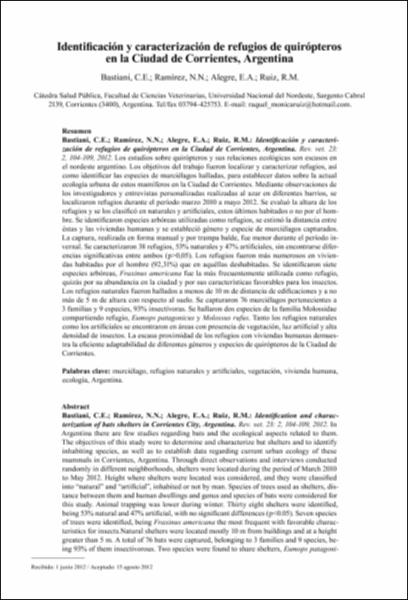Identificación y caracterización de refugios de quirópteros en la ciudad de Corrientes, Argentina
Identification and characterization of bats shelters in Corrientes City, Argentina
Fecha
2012-08-01Autor
Bastiani, Cristian Eduardo
Ramírez, N. N.
Alegre, Elsa Agustina
Ruiz, Raquel Mónica
Metadatos
Mostrar el registro completo del ítemResumen
Los estudios sobre quirópteros y sus relaciones ecológicas son escasos en el nordeste argentino. Los objetivos del trabajo fueron localizar y caracterizar refugios, así como identificar las especies de murciélagos halladas, para establecer datos sobre la actual ecología urbana de estos mamíferos en la Ciudad de Corrientes. Mediante observaciones de los investigadores y entrevistas personalizadas realizadas al azar en diferentes barrios, se localizaron refugios durante el período marzo 2010 a mayo 2012. Se evaluó la altura de los refugios y se los clasificó en naturales y artificiales, estos últimos habitados o no por el hombre. Se identificaron especies arbóreas utilizadas como refugios, se estimó la distancia entre éstas y las viviendas humanas y se estableció género y especie de murciélagos capturados. La captura, realizada en forma manual y por trampa balde, fue menor durante el período invernal. Se caracterizaron 38 refugios, 53% naturales y 47% artificiales, sin encontrarse diferencias significativas entre ambos (p>0,05). Los refugios fueron más numerosos en viviendas habitadas por el hombre (92,31%) que en aquéllas deshabitadas. Se identificaron siete especies arbóreas, Fraxinus americana fue la más frecuentemente utilizada como refugio, quizás por su abundancia en la ciudad y por sus características favorables para los insectos. Los refugios naturales fueron hallados a menos de 10 m de distancia de edificaciones y a no más de 5 m de altura con respecto al suelo. Se capturaron 76 murciélagos pertenecientes a 3 familias y 9 especies, 93% insectívoras. Se hallaron dos especies de la familia Molossidae compartiendo refugio, Eumops patagonicus y Molossus rufus. Tanto los refugios naturales como los artificiales se encontraron en áreas con presencia de vegetación, luz artificial y alta densidad de insectos. La escasa proximidad de los refugios con viviendas humanas demuestra la eficiente adaptabilidad de diferentes géneros y especies de quirópteros de la Ciudad de Corrientes. In Argentina there are few studies regarding bats and the ecological aspects related to them. The objectives of this study were to determine and characterize bat shelters and to identify inhabiting species, as well as to establish data regarding current urban ecology of these mammals in Corrientes, Argentina. Through direct observations and interviews conducted randomly in different neighborhoods, shelters were located during the period of March 2010 to May 2012. Height where shelters were located was considered, and they were classified into “natural” and “artificial”, inhabited or not by man. Species of trees used as shelters, distance between them and human dwellings and genus and species of bats were considered for this study. Animal trapping was lower during winter. Thirty eight shelters were identified, being 53% natural and 47% artificial, with no significant differences (p<0.05). Seven species of trees were identified, being Fraxinus americana the most frequent with favorable characteristics for insects.Natural shelters were located mostly 10 m from buildings and at a height greater than 5 m. A total of 76 bats were captured, belonging to 3 families and 9 species, being 93% of them insectivorous. Two species were found to share shelters, Eumops patagonicus and Molossus rufus, an interesting association for behavioral studies. Both natural and artificial shelters were found in areas of vegetation, artificial light and high density of insects. The short proximity of shelters to human populations demonstrates the efficient adaptability of the different genera and species of bats from the City of Corrientes.
Colecciones
- Artículos de revista [443]





